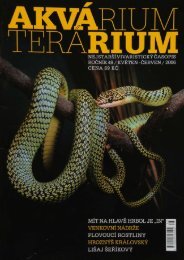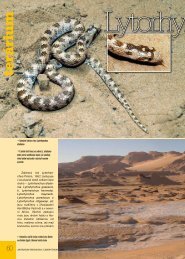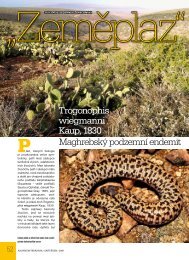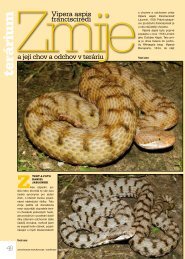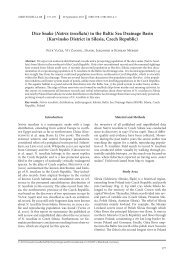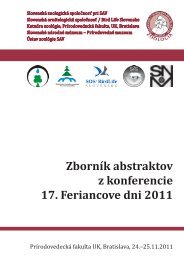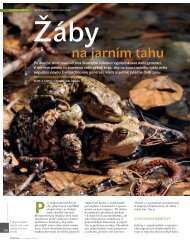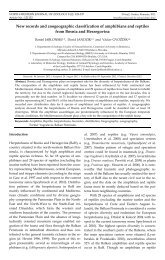Slow worm, Anguis fragilis (Reptilia: Anguidae ... - Daniel Jablonski
Slow worm, Anguis fragilis (Reptilia: Anguidae ... - Daniel Jablonski
Slow worm, Anguis fragilis (Reptilia: Anguidae ... - Daniel Jablonski
Create successful ePaper yourself
Turn your PDF publications into a flip-book with our unique Google optimized e-Paper software.
V. Gvoždík et al. / Molecular Phylogenetics and Evolution 55 (2010) 460–472 471<br />
cated in the zone of an important glacial refugium (Joger et al.,<br />
2007; Taberlet et al., 1998). Different sublineages in several microrefugia<br />
are thus likely to have persisted. On the other hand, the genetic<br />
uniformity of A. <strong>fragilis</strong> s.s. is surprising. Although our<br />
sampling of the species range is not comprehensive, we included<br />
geographically very distant populations such as the Iberian versus<br />
Slovak, or even the Greek, to prevent a possible bias caused by under-sampling.<br />
Nevertheless, the average intra-specific mtDNA variation<br />
is very low (0.5%), and most of the mutations within the ND2<br />
gene were found to be synonymous. It is possible that the Spanish<br />
as well as the Greek populations resulted from a recent colonization,<br />
and the refugium of A. <strong>fragilis</strong> s.s. was located elsewhere. Here,<br />
Apennine Peninsula, southern France, and/or the north-western<br />
Balkans, which we did not sample (with the exception of one Slovenian<br />
sample, which is phylogenetically outside the group formed<br />
by other mt haplotypes of A. <strong>fragilis</strong> s.s. examined) come into account.<br />
The second possible explanation, however far less likely, is<br />
that there is a low substitution rate within this species. It would<br />
also mean that the origin of this species dated to the late Miocene<br />
based on mean mt genetic distance comparison is underestimated.<br />
As discussed above, A. colchica shows the most distinct intra-specific<br />
differentiation, which is probably related to the existence of<br />
several separate Pleistocene refugia. In comparison to the Caucasian<br />
(B2) and Caspian (B3) subclades, the European subclade (B1)<br />
shows relatively lower genetic variation. We could hypothesize<br />
that it is due to incomplete sampling, as we have virtually no individuals<br />
from prospective refugia of the subclade B1, which could<br />
be located in the Carpathian Basin, or in the north-eastern Balkans.<br />
4.5. Current knowledge of morphological differentiation<br />
The morphology of the newly recognized species is not known<br />
sufficiently, as many available morphological studies (Lác, 1967;<br />
Shcherban’, 1976; Voipio, 1962; Wermuth, 1950) dealt with samples<br />
containing mixtures of different species. Nonetheless, some<br />
morphological traits historically distinguishing two morphotypes<br />
(e.g. Dely, 1981), i.e. ‘‘<strong>fragilis</strong>” and ‘‘colchica”, could be roughly applied<br />
to A. <strong>fragilis</strong> s.s. (prefrontal shields in broad contact; ear opening<br />
indistinct; 24–26 scales around the midbody; blue dorsal<br />
spotting infrequent, present only in males) and A. colchica (prefrontal<br />
shields usually separated, sometimes in point contact and only<br />
rarely in broad contact; ear opening usually distinct, visible; 26–30<br />
scales around the midbody; blue dorsal spotting frequent in males<br />
and occasionally present also in females), respectively. A. graeca remains<br />
morphologically the most enigmatic, as its populations are<br />
known to display intermediate or mosaic characters of the ‘‘<strong>fragilis</strong>”<br />
and ‘‘colchica” morphotypes (Cabela and Grillitsch, 1989; Grillitsch<br />
and Cabela, 1990). Detailed morphological study of the species<br />
complex is under preparation by the authors.<br />
4.6. Conservation<br />
The slow <strong>worm</strong>, A. <strong>fragilis</strong> s.l., has been suggested as Least Concern<br />
under the IUCN criteria (Cox et al., 2006). It is believed to be a<br />
widely distributed and quite common species. However, its cryptic<br />
ecology complicates a proper evaluation of populations’ densities<br />
and possible threat in situ. Beside these general complications for<br />
evaluation of conservation status, the genetic structure has totally<br />
been omitted so far. This should be changed now, considering the<br />
slow <strong>worm</strong>, A. <strong>fragilis</strong> s.l., to be composed of three species, A. <strong>fragilis</strong><br />
s.s., A. colchica and A. graeca. The first two species are seemingly<br />
widespread across Western and Eastern Europe, respectively, while<br />
A. graeca seems to be a more geographically limited species, which<br />
calls for further attention to the Mediterranean Basin as a global<br />
biodiversity hotspot (Myers et al., 2000) and to the importance of<br />
the Balkan Peninsula in particular.<br />
The evolutionary differentiation within the genus <strong>Anguis</strong> presented<br />
in our study should be taken into account in all future conservation<br />
efforts, as well as in all biogeographical, morphological,<br />
ecological, and/or ethological studies.<br />
Acknowledgments<br />
We would like to thank (alphabetically) to L. Choleva, J. Hotový,<br />
H. in den Bosch, K. Janoušek, M. Kolařík, M. Kostovčík, J. Lokajová,<br />
R. Musilová, P. Pavlík, A. Pončová, R. Rozínek, R. Šanda, A. Šašková,<br />
H. Šifrová, R. Smolinský, B. Švecová and V. Zavadil who provided<br />
tissue samples, or helped with their collecting. E.M. Albert and R.<br />
Zardoya (MNCN Madrid) provided at that time an unpublished sequence.<br />
We are also thankful to P. Balej for his help with the graphics,<br />
W. Böhme (ZFMK Bonn) for his valuable comments and<br />
discussion about the nomenclature, P. Kotlík (IAPG CAS Liběchov)<br />
for general discussion and advices to phylogenetic methodology,<br />
J.M. Meik (University of Texas at Arlington) for improving the language,<br />
and A. Vogler (NHM London), A. Larson (Washington University<br />
in St. Louis) and three anonymous reviewers for their<br />
comments, which improved previous versions of the manuscript.<br />
Thanks are given also to the Agency for Nature Conservation and<br />
Landscape Protection of the Czech Republic for the permit No.<br />
0555/PO/2009/AOPK, the Ministry of the Environment of the Slovak<br />
Republic for the permit No. 1323/527/05-5.1 and the Greek<br />
Ministry of Agricultural Development and Foods for the permit<br />
No. 92221/2067 they issued. This study was supported by the<br />
internal grant of the National Museum, Prague, and by DE06-<br />
P04OMG008, MK00002327201, LC06073, IRP IAPG AV0Z<br />
50450515, and VEGA 1/4332/07.<br />
Appendix A. Supplementary data<br />
Supplementary data associated with this article can be found,<br />
in the online version, at doi:10.1016/j.ympev.2010.01.007.<br />
References<br />
Akaike, H., 1974. A new look at the statistical model identification. IEEE Trans.<br />
Automatic Control 19, 716–723.<br />
Albert, E.M., San Mauro, D., García-París, M., Rüber, L., Zardoya, R., 2009. Effect of<br />
taxon sampling on recovering the phylogeny of squamate reptiles based on<br />
complete mitochondrial genome and nuclear gene sequence data. Gene 441,<br />
12–21.<br />
Anisimova, M., Gascuel, O., 2006. Approximate likelihood-ratio test for branches: a<br />
fast, accurate, and powerful alternative. Syst. Biol. 55, 539–552.<br />
Arnold, E.N., 2002. Reptiles and amphibians of Europe, second ed. Princeton Univ.<br />
Press, Princeton and Oxford.<br />
Ast, J.C., 2001. Mitochondrial DNA evidence and evolution in Varanoidea<br />
(Squamata). Cladistics 17, 211–226.<br />
Avise, J.C., 2000. Phylogeography: The History and Formation of Species. Harvard<br />
University Press, Cambridge.<br />
Baker, R.J., Bradley, R.D., 2006. Speciation in mammals and the genetic species<br />
concept. J. Mammal. 87, 643–662.<br />
Bárta, Z., Tyrner, P., 1972. Finding of <strong>Anguis</strong> <strong>fragilis</strong> colchicus in Moravia, and notes to<br />
the subspecies affiliation of slow <strong>worm</strong>s from the Ore Mts. Ochrana fauny<br />
(Bratislava) 6, 84 (in Czech).<br />
Bermingham, E., McCafferty, S.S., Martin, A.P., 1997. Fish biogeography and<br />
molecular clocks: perspectives from the panamanian isthmus. In: Kocher,<br />
T.D., Stepien, C.A. (Eds.), Molecular Systematics of Fishes. Academic Press, San<br />
Diego, pp. 113–128.<br />
Beshkov, V., 1966. Investigations on the systematics and distribution of the slow<br />
<strong>worm</strong> (<strong>Anguis</strong> <strong>fragilis</strong> L.) in Bulgaria. Bull. Inst. Zool. Mus. 21, 185–201 (in<br />
Bulgarian with Russian and German Abstracts).<br />
Cabela, A., Grillitsch, H., 1989. Zum systematischen Status der Blindschleiche<br />
(<strong>Anguis</strong> <strong>fragilis</strong> Linnaeus, 1758) von Nordgriechenland und Albanien (Squamata:<br />
<strong>Anguidae</strong>). Herpetozoa 2, 51–69.<br />
Clement, M., Posada, D., Crandall, K.A., 2000. TCS: a computer program to estimate<br />
gene genealogies. Mol. Ecol. 9, 1657–1659.<br />
Cox, N., Chanson, J., Stuart, S. (Eds.), 2006. The Status and Distribution of Reptiles<br />
and Amphibians of the Mediterranean Basin. IUCN, Gland and Cambridge.<br />
Dely, O.G., 1981. <strong>Anguis</strong> <strong>fragilis</strong> Linnaeus 1758 – Blindschleiche. In: Böhme, W. (Ed.),<br />
Handbuch der Reptilien und Amphibien Europas. Band 1. Echsen (Sauria) 1.<br />
AULA-Verlag, Wiesbaden, pp. 241–258.



